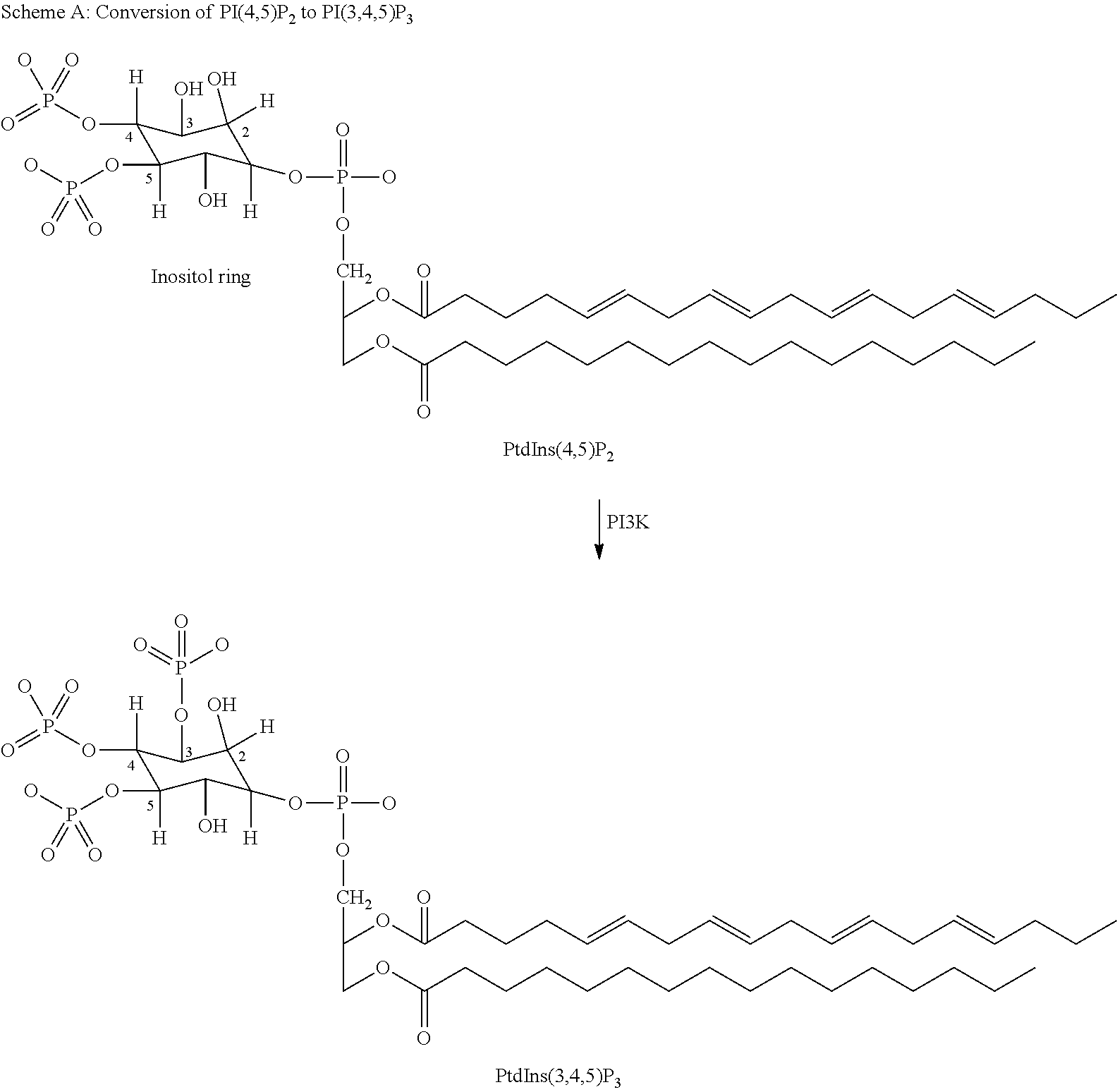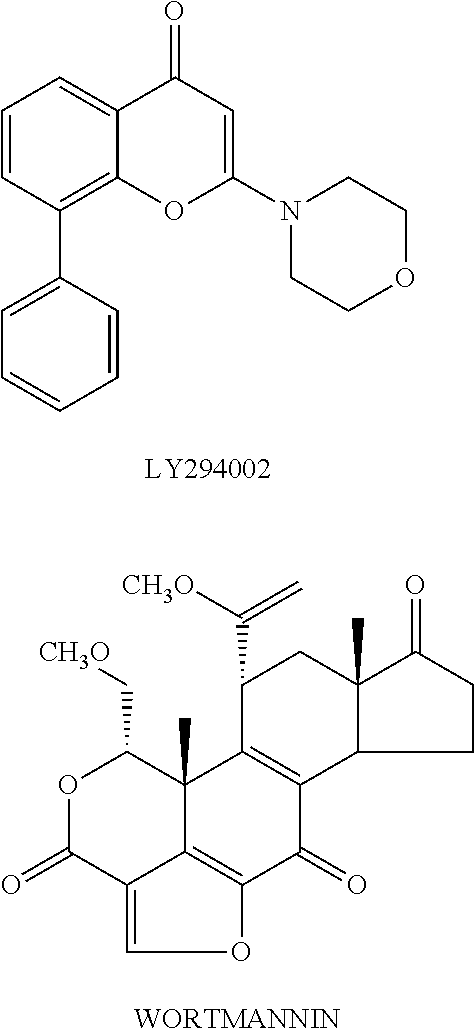Benzpyrazole derivatives as inhibitors of pi3 kinases
a technology of benzpyrazole derivatives and inhibitors, applied in the direction of drug compositions, immune disorders, extracellular fluid disorders, etc., can solve the problem of limited expression of the enzym
- Summary
- Abstract
- Description
- Claims
- Application Information
AI Technical Summary
Benefits of technology
Problems solved by technology
Method used
Image
Examples
example 1
2-[(8aS)-Hexahydropyrrolo[1,2-a]pyrazin-2(1H)-ylmethyl]-N-[6-(1H-indol-4-yl)-1H-indazol-4-yl]-1,3-thiazole-4-carboxamide
[0575]
[0576]2-(Chloromethyl)-N-[6-(1H-indol-4-yl)-1-(phenylsulfonyl)-1H-indazol-4-yl]-1,3-thiazole-4-carboxamide (49 mg) and sodium iodide (13 mg) were dissolved in MeCN (1 ml) before (8aS)-octahydropyrrolo[1,2-a]pyrazine (23 mg) and DIPEA (0.031 ml) were added. The reaction mixture was heated at 70° C. for 1 h 30 min. The reaction mixture was cooled to RT then the solvent was removed under nitrogen. IPA (2 ml) and 2M NaOH (aq) (2 ml) were added and the reaction mixture was stirred for 30 h at RT. The reaction mixture was neutralised with 2M HCl (aq) until pH=7. The solvent was removed under nitrogen and the residue was dissolved in DMSO (2 ml), passed through a hydrophobic frit, then purified by MDAP (method A). The solvent was removed under nitrogen, and the residue was dissolved in water:dioxane (1:1) then freeze-dried to give the title compound, 7 mg.
[0577]LCMS...
example 2
2-{[(3R,5S)-3,5-Dimethyl-4-(1-methylethyl)-1-piperazinyl]methyl}-N-[6-(1H-indol-4-yl)-1H-indazol-4-yl]-1,3-thiazole-4-carboxamide
[0578]
[0579]2-(Chloromethyl)-N-[6-(1H-indol-4-yl)-1-(phenylsulfonyl)-1H-indazol-4-yl]-1,3-thiazole-4-carboxamide (50 mg), (2R,6S)-2,6-dimethyl-1-(1-methylethyl)piperazine (which can be prepared as described in J. Med. Chem. 1999, 42, 1123-1144) (0.5 ml), potassium carbonate (38 mg) and MeCN (1 ml) were combined in a microwave vial then heated in the microwave for 15 min at 100° C. The solvent was removed under a flow of nitrogen. IPA (2 ml) and 2M NaOH (aq) (2 ml) were added and the reaction mixture was stirred for 72 h at RT before warming to 50° C. for 3 h 30 min. The reaction mixture was cooled then neutralised using 2M HCl (aq) until pH=7. The solvent was removed under a flow of nitrogen and the residue was dissolved in DMSO (2 ml), filtered and purified by MDAP (method A). The solvent was removed under a flow of nitrogen from the pure fraction to give...
example 3
2-{[(3R,5S)-3,5-Dimethyl-4-(1-methylethyl)-1-piperazinyl]methyl}-N-(6-{6-(methyloxy)-5-[(methylsulfonyl)amino]-3-pyridinyl}-1H-indazol-4-yl)-1,3-thiazole-4-carboxamide
[0581]
[0582]2-(Chloromethyl)-N-[6-{6-(methyloxy)-5-[(methylsulfonyl)amino]-3-pyridinyl}-1-(phenylsulfonyl)-1H-indazol-4-yl]-1,3-thiazole-4-carboxamide (40 mg), potassium carbonate (26 mg) and (2R,6S)-2,6-dimethyl-1-(1-methylethyl)piperazine (which can be prepared as described in J. Med. Chem. 1999, 42, 1123-1144) (10 mg) were added to MeCN (1 ml). The reaction mixture was heated in the microwave for 15 min at 110° C. The solvent was evaporated under a flow of nitrogen. IPA (2 ml) and 2M NaOH (aq) (2 ml) were then added and the reaction mixture was stirred for 30 h. The reaction was neutralised with 2M HCl (aq) to pH=7 and the solvent was evaporated under a flow of nitrogen. The residue was dissolved in DMSO (2 ml), filtered and purified by MDAP (method A). The pure fraction was evaporated under a flow of nitrogen, diss...
PUM
| Property | Measurement | Unit |
|---|---|---|
| Fraction | aaaaa | aaaaa |
| Fraction | aaaaa | aaaaa |
| Fraction | aaaaa | aaaaa |
Abstract
Description
Claims
Application Information
 Login to View More
Login to View More - R&D
- Intellectual Property
- Life Sciences
- Materials
- Tech Scout
- Unparalleled Data Quality
- Higher Quality Content
- 60% Fewer Hallucinations
Browse by: Latest US Patents, China's latest patents, Technical Efficacy Thesaurus, Application Domain, Technology Topic, Popular Technical Reports.
© 2025 PatSnap. All rights reserved.Legal|Privacy policy|Modern Slavery Act Transparency Statement|Sitemap|About US| Contact US: help@patsnap.com



